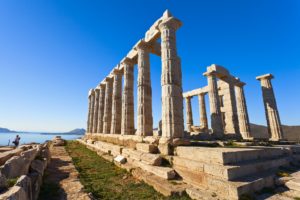The Athens Classic Marathon (the authentic Marathon) is an annual marathon road race held in Athens, Greece, most times in early November.
The race attracted 43.000 competitors in 2015 of which 16.000 were for the 42.195 km course while the rest of the runners competed in the concurrent 5 and 10 kilometers road races and the racewalking contest. Both numbers were a record for the event.
The History of Marathon Race
The marathon course is based on the legend from which the race gained its name; Pheidippides, a messenger in Ancient Greece, ran from the Battle of Marathon to Athens to announce the Greeks’ victory over the Persians.
The provenance of the competitive race is traced back to the Marathon race at the 1896 Olympics. The Athens Classic Marathon began in 1972 as a joint venture between the Greek tourist board and athletics association. The race came under the auspices of the current organizers and SEGAS in 1983 and since has become a major race, being awarded Gold Label Road Race status by the IAAF.
It is perhaps the most challenging major marathon race: the course is uphill from the 10 km mark to the 31 km mark – the toughest uphill climb of any major marathon. The course begins in the town of Marathon, where it passes the tomb of the Athenian soldiers, and it traces a path near the coast through Nea Makri. Following the steep rise, the course goes slightly downhill towards the city of Athens. It passes a statue of a runner (Ο Δρομέας) in the city center before finishing up at the Panathinaiko Stadium; a site for athletics competitions in ancient times and the finishing point for both the 1896 and 2004 Olympic marathons.
In 1982, the organizers dedicated the race to Grigoris Lambrakis, an athlete and Member of the Greek Parliament, whose murder in the 1960s has become an inspirational cause for advocates of human rights. Since 2007 the Association of International Marathons and Distance Races has organized an annual International Marathon Symposium in Marathon town the day before the race. The tradition of the Olympic Torch is also held here. The race features the Marathon Flame, which is lit at the Tomb of the Battle of Marathon and carried to the stadium in Marathon before the beginning of each race. The 2010 edition of the event was combined with the celebration of the 2500th anniversary of the Battle of Marathon.
Greek competitors have traditionally been strong in the men’s and women’s competitions. However, East Africans and Japanese runners have increasingly become the dominant athletes from 1999 onwards. Since 1990, the Athens Classic Marathon has often served as the Greek national championships for the marathon event. The current course records are 2:10:37 hours for men, set by Felix Kandie in 2014, while Rasa Drazdauskaitė’s run of 2:31:06 in 2010 is the quickest by a woman on the course. In 2016, a refugee team competed in the concurrent 5 kilometers road race of the Marathon
The Athens Classic Marathon today
The Marathon Race starts at 09.00 sharp from the Marathon Start Venue in the town of Marathon.
The first 200m of the course are sloping, leading the runners away from the Start area. The first 4 kilometers go downhill. The runners run along the Marathonos Avenue up to the 4thkm, where they turn left and enter the Marathonomachon Str., and area of the Marathon Tomb (War Memorial), which they follow for the next 2.2km. The course follows a rather circular route around the War Memorial.
The course becomes flat from the 6th to the 10th km (Nea Makri). From the 11th to the 17thkm the course goes uphill at certain parts. Then, and up to Rafina Junction, the runners meet a steep descent. Starting from the Rafina Junction, the course goes uphill again, while the most challenging part is found up to the 20thkm. As the runners pass along the district of Pikermi, they run through some of the more or less uphill parts of the course up to the 25th km. The passage through the city of Pallini (27km – 28km) is also uphill. The last and hardest part of the course starts from Gerakas and goes up to Stavros Junction (30km – 31km). This steep ascent is followed by a steep descent leading to the Agia Paraskevi Square. Then, the runners follow the Mesogeion Avenue, going through the districts of Chalandri and Cholargos, meeting flat and downhill parts of the course up to the finish. The essential downhill part starts from the Ministry of National Defense and ends at the Katechaki Junction (37.5km), where the runners pass under the relevant bridge.
Right after the Erricos Dynnan Hospital, the runners continue left on Michalakopoulou Avenue until the traffic lights at Michalakopoulou and Pheidippidou crossroad. They keep running on Pheidippidou Str. until the crossroad at Kiffisias & Alexandras Avenue. The latter crossroad highlights the 39thkm, while the runners continue left on Vas. Sofias Avenue. On Vas. Sofias Avenue, the runners pass by the American Embassy, the Athens Music Hall and the Park of Liberty (40km), where the last feed zone is located. As they reach the Hilton Hotel, they slightly turn right heading towards the Syntagma Square, passing by the Evaggelismos Hospital and the War Museum.
At the last part of the Marathon Course and having turned on the Irodou Attikou Street, the runners have eye contact with the Panathenaic Stadium, passing by the Presidential Residency and the National Gardens. Only a few meters remain for the athletes to enter the Stadium and run the last meters inside it, before reaching the finish line.
The runners enter the Panathenaic Stadium from the left side, where the Finish Arch is found.
STARTING BLOCKS
All runners will be allocated in ten (10) different starting blocks in the start area based on their bib numbers and its color. The allocation of blocks is made according to the performances stated by the runners themselves on their registration form, and they concern the last three years (2014-2016). In case no performance is indicated on the registration form, the runner will be automatically placed in one of the last two blocks.
RACE START
A “Wave start” system is implemented, while ten (10) different “wave starts” are given. Τhe latest 15 minutes before the start (at 08:45), the runners should be found in the appropriate starting blocks, as it will be indicated on their bib number. Based on the above, the runners should not worry as their net running time will also be recorded.
It is important to say that for someone to participate in the Marathon Race, he/she should be at least 18 years old.
TIME LIMIT TO FINISH THE RACE
The Marathon Race and Power Walking are concluded at 17.40, by when all runners should have reached the finish line.


